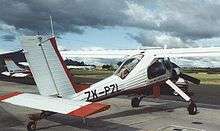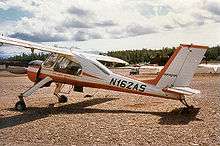PZL-104 Wilga
| PZL-104 Wilga | |
|---|---|
| | |
| PZL-104 Wilga 35 | |
| Role | Utility aircraft |
| National origin | Poland |
| Manufacturer | PZL Warszawa-Okęcie |
| First flight | 24 April 1962 |
| Status | Production Ended |
| Primary user | Polish military and civilian aviation |
| Produced | 1962-2006 |
| Number built | 1000+ |
|
| |
PZL-104 Wilga ("golden oriole") is a Polish designed and built short-takeoff-and-landing (STOL) Civil Aviation utility aircraft manufactured by PZL "Warszawa-Okęcie". The Wilga has evolved through many ever-improving versions during its continuous production from 1962 to 2006, when the European Aeronautic Defence and Space Company (EADS) announced on their website the production of this aircraft would cease.
Design and development
The PZL-104 was designed for robust use in sports, civil aviation, with a strong emphasis on glider-towing and parachute training. The prototype of the initial Wilga Mark 1 variant was first flown on 24 April 1962 powered by an existing Polish 220 hp (160 kW) horizontally-opposed engine the PZL WN-6RB. The Wilga 1 prototype exposed a number of design faults, the most serious of which was excessive weight and a rear view restriction such that the crew could not easily see a towed glider. This resulted in an airframe review that thoroughly redesigned the aircraft, led by Bronisław Żurakowski and Andrzej Frydrychewicz.
Retaining major structural elements and successful sub-assemblies from the wings in the initial design, a completely new slimmer, strengthened fuselage was added that also offered an excellent rear view aspect for the crew during glider towing operations, and the side doors were re-engineered to open upwards for better aero observation or parachute jump sorties. The upgraded aircraft could be flown with the doors open if required, and had an air ambulance conversion capability.
The new PZL-104 Wilga Mark 2 variant first flew on 1 August 1963, followed by a short production run which later was converted to the Wilga C and Wilga Mark 3 configurations. On 30 December 1963 the Wilga C (or Wilga Mark 2 Subvariant C) was flown, an export variant for Indonesia powered by the imported North American -certified 225 hp (168 kW) horizontally-opposed Continental O-470 engine. The Wilga 2 airframe had proved a successful design, but the WN-6RB engine was not fully developed and so did not enter serial production. As a result, it was decided to use an in-production radial engine, the 260 hp (190 kW) Ivchenko AI-14R; and this led to the PZL-104 Wilga Mark 3 variant, which first flew on 31 December 1965. The new engine was more powerful but it spoilt the previously clean and aerodynamic fuselage lines, originally designed for a flat engine; nonetheless, the new variant was successful. Due in combination to the power of the engine and the STOL capability of the airframe, an extraordinary high rate of climb of 11 m/s (2,165 fpm) (maximum) under minimal load was possible. One of a few remaining flaws was a relatively uneconomical engine.

The Wilga 32 was an improved small-series export variant with a Continental flat engine, produced also in Indonesia as the "Gelatik". After producing 13 Wilga 3s there were some improvements made, most notably a landing gear base increased from 2.12 to 2.83 m (7.0 to 9.3 ft) to improve stability. An improved model, designated PZL-104 Wilga 35, first flew on 29 June 1967, subsequently entering mass production. The most numerous variant of Wilga 35 was the utility plane Wilga 35A, others were built in small numbers or remained prototypes.
From 1979 the Wilga 80 went into production, an improved model certified for the US market. In the late 1990s the PZL-104MA Wilga 2000 [1] family was developed with Lycoming flat engines and with improved aerodynamics.
Over 1,000 Wilgas of all types have been built, including 935 of the Wilga 35 and 80. This means more PZL-104 have been produced than any other Polish aircraft design.
A Canadian aircraft supplier considered building the Wilga aircraft for the Air Cadet league due to its complete compliance with glider training requirements, and the need for more aircraft, but were unable to get the necessary support of EADS to further produce the PZL-104MA Wilga 2000.[2]
Description
With an all-aluminium construction, the Wilga is a high-wing cantilever STOL monoplane, with a conventional layout. The main cabin is constructed of duralumin, riveted and corrugated, increasing the strength and durability of the low-mass semi-monocoque fuselage. The rectangular single-spar wing is fitted with slotted flaps and anti-stall slats. The four-seat cabin is fitted with two large side doors, opening upwards to facilitate large loads, and rapid entry/exit. The main wheels are attached to an articulated, conventional fixed pneumatic shock landing gear with a heavy-duty sprung tail wheel and glider tow hook. The two-bladed composite wooden propeller is strengthened with bonded metal leading edges. The Russian-designed engine rotates in an opposite direction to North American standards. The newest models of Wilgas use full metal propellers and North American Continental O-470 engines with standard rotation. Likewise, presently two 195 L (43 imp gal; 52 US gal) fuel tanks are located in the wings.
Variants

%2C_static_display%2C_Radom_AirShow_2005%2C_Poland.jpg)

- Wilga 2
- First production variant with WN-6 flat engine (small series - about 10, converted to Wilga C and 3).
- Wilga 3A
- Aero club aircraft.
- Wilga 3S
- Air ambulance aircraft.
- Wilga C (2C)
- Wilga 2 with Continental O-470 engine for Indonesia. 16 aircraft built in Poland, with some assembled in Indonesia.
- Wilga 3
- Modified serial variant with AI-14 radial engine, 13 built (including 2 converted Wilga 2s).
- Wilga 32
- Wilga 3 with Continental O-470 engine for Indonesia. 6 aircraft built in Poland, 18 in Indonesia under a name Gelatik. Some were fitted as agricultural aircraft.
- Wilga 35
- Basic variant with AI-14 engine.
- Wilga 35A
- Mass-produced basic variant for sports aviation, with glider towing hook, produced from 1968.
- Wilga 35H
- Floatplane export variant built in cooperation with Canada, flown 30 October 1979.
- Wilga 35P
- Military liaison or passenger variant (without towing hook), flown in 1968.
- Wilga 35R
- Agricultural aircraft of 1978, with 300 l of chemicals (probably not built in series).
- Wilga 35S
- Air ambulance of 1968, 1 made.
- Wilga 40
- Variant with one-piece elevators flown in 1969, 2 prototypes only.
- Wilga 80
- Wilga 35 modified in accordance with FAR regulations for US market, of 1979, powered by PZL AI-14RA engine, serial production.
- Wilga 80/1400 (80H)
- Export floatplane variant of 1982 built in cooperation with Canada, powered by PZL AI-14RD (206 kW /280 HP) engine.
- Wilga 80/550 Melex
- Wilga 80 fitted with Continental flat engine in the USA, of 1992 (prototype)
- Wilga 88
- Development of Wilga in the 1980s, that led to PZL-105 Flaming.
- PZL-104M Wilga 2000
- Variant with Lycoming flat engine, modified wings and improved aerodynamics, produced from 1998.
- PZL-104MW Wilga 2000 Hydro
- Floatplane variant of Wilga 2000, flown on 19 September 1999.
- PZL-104MF Wilga 2000
- Patrol version of Wilga 2000 for Polish Border Guard.
- PZL-104MN Wilga 2000
- Newer version from 2001.
- PZL-104MA Wilga 2000
- Last variant of Wilga 2000 made in 2005, with improved aerodynamics and winglets, powered by Lycoming I0-540 300 hp engine. No longer in production.
- Gelatik
- license-built version produced in Indonesia
Service
Wilgas are used in civil aviation for touring, observation, glider towing, parachute training and bush flying. In Poland, they form the backbone contingent of the Polish Aero Club where they are the basic aircraft used in flight training. Polish pilots flying Wilgas have won numerous prizes in the FAI World Rally Flying and Precision Flying Championships, from 1978 to 2006. In military service they are used as liaison, recovery and light observation platforms.
Operators
Military operators
- Egyptian Air Force - Former operator.
- Estonian Air Force - Former operator.
- Latvian Air Force
- Latvian National Guard - Former operator.
- Lithuanian Air Force - Former operator.
- Lithuanian National Defence Volunteer Forces - Ex-DOSAAF aircraft.
- Moldova Air Force - 5 aircraft in service.
- Mongolian Air Force - Former operator.
- Paraguayan Air Force operated 2 aircraft between 1996 and 2003.
- Polish Air Force operated 17 aircraft between 1973 and 1993.
- Polish Border Guard operates some (5 in 2005) PZL-104MF Wilgas 2000 as patrol aircraft.
- Polish Navy - Former operator.
- Republika Srpska Air Force - Former operator.
Civilian operators
- Royal Canadian Air Cadets - 1 (former operator)
- Ridali Airfield - 1, but used to operate at least 3.
- Rapla(Kuusiku) Airfield - 2, one of them rarely used.
- Hungarian Police - Former operator.
- Romanian Airclub - Unknown exact number (around 10). Private owners - At least two
- Turkish Aeronautical Association - mainly used for aerotowing of gliders
- Wilga'Beast' (M14P Powered - airshows|events).
Accidents and incidents
- On 6 May 2010, a PZL-104 carrying UK Independence Party (UKIP) leader Nigel Farage crashed at Hinton-in-the-Hedges Airfield, Northamptonshire.
- On 12 Jan 1996, a PZL-104 (VH-PZS) crashed on North Stradbroke Island near Brisbane. The pilot and his three passengers were killed.[3]
Specifications (Wilga 35A)
Data from [4]
General characteristics
- Crew: 1
- Capacity: 3
- Length: 8.10 m (26 ft 6 in)
- Wingspan: 11.12 m (36 ft 5 in)
- Height: 2.96 m (9 ft 6 in)
- Wing area: 15.50 m2 (166.85 ft2)
- Empty weight: 900 kg (1984 lb)
- Gross weight: 1300 kg (2868 lb)
- Powerplant: 1 × Ivchenko AI-14RA air-cooled 9-cylinder radial piston engine, 194 kW (260 hp)
Performance
- Maximum speed: 195 km/h (121 mph)
- Range: 670 km (416 miles)
- Service ceiling: 4040 m (13,255 ft)
- Maximum glide ratio: 1/4
- Rate of climb: 5.5 m/s (1082 ft/min)
See also
- Related development
- Aircraft of comparable role, configuration and era
References
- ↑ Picture of the PZL-Okecie PZL-104MA Wilga-2000 aircraft
- ↑ The Air Cadet League of Canada - Annual Report 2007: L-19 Aircraft Replacement Program
- ↑ http://www.atsb.gov.au/publications/investigation_reports/1996/aair/aair199600094.aspx
- ↑ Orbis 1985, page 2675
- Andrzej Glass: Tysiąc Wilg ("Thousand Wilgas") in Skrzydlata Polska nr. 6/2004 (Polish language)
- The Illustrated Encyclopedia of Aircraft (Part Work 1982-1985). Orbis Publishing. 1985.
- The Air Cadet League of Canada: Annual Report 2006/2007
- Eads Wilga termination: Eads Termination PZL 104 Wilga
External links
| Wikimedia Commons has media related to PZL-104 Wilga. |